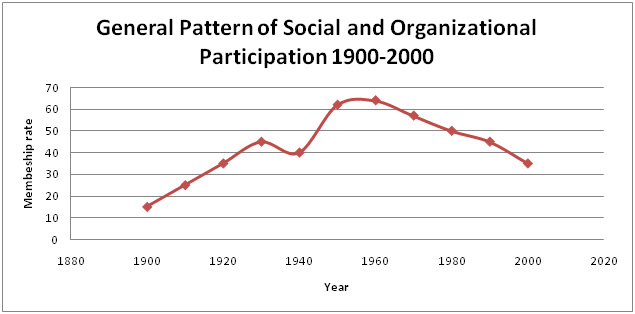
Participation in Social Groups over time, adapted from Putnam
The steady erosion in Square Dance membership is of concern to us all. In doing research into ways to fight the trend, I discovered that Robert D. Putnam, a political scientist at Harvard University, has studied a more general form of the problem and has produced several books on the topic. His "Bowling Alone" was published in 2000 and offers considerable insight into the problem.
I here draw attention to several points extrapolated from his popularly published but nonetheless detailed and scholarly work. I alone am responsible for the interpretation of his work as it applies to square dancing given here and I regret any misrepresentation of his ideas. I strongly recommend his book.
In the first place, we (square dancers) are not alone. Virtually all forms of communal activities (visiting with friends, voting, bowling in leagues, attending church, belonging to the Knights of Columbus, Parent-Teacher organizations, NAACP, and so on) follow similar patterns. With appropriate scale adjustments, most participation metrics graphed over time look something like this (the membership metric is intentionally unspecified):

Participation in Social Groups over time, adapted from Putnam
The great depression set back participation but after WWII there was a steady rise until the late 1960s or so; from then on we have seen a steady decline in
participation. People will often claim membership in various organizations, but non-participatory membership is not of interest here (most people who "belong" to
Greenpeace simply pay dues).
Putnam believes, but indicates these are his estimates, that the important elements leading to the steady decline in communal activities are, in rough order of importance:
Putnam says that these factors together are far from sufficient to answer the whole question; there are important missing pieces.
One of the brightest spots in his book, offering a powerful argument when we recruit, is the powerful and well documented health benefits of participation - even in organizations that have no exercise component.
What follows is a statistical result, but Putnam makes plausible arguments for causation; for details on the studies that reached this and similar conclusions you'll need to look at his writings.
As a rough rule of thumb, if you belong to no groups but decide to join one, you cut your risk of dying over the next year in half (!). The connection of health and social capital persisted even when the studies took into account social class, race, gender, smoking, drinking, obesity, lack of exercise, and (significantly) health problems. Further, people who developed health problems did better, and appeared to respond better, when they had social connections.
Improve your life - make friends - square dance.
If you are interested in learning to square dance, or are taking lessons, please consider the instructional and square dance videos at:
www.travelinghoedowners.com